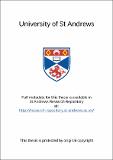Files in this item
Theory of transition metal impurities in semiconductors
Item metadata
| dc.contributor.advisor | Allen, J. F. | en |
| dc.contributor.author | O'Neill, A. G. | en |
| dc.coverage.spatial | xi,250p | en |
| dc.date.accessioned | 2021-04-08T08:59:19Z | |
| dc.date.available | 2021-04-08T08:59:19Z | |
| dc.date.issued | 1984 | |
| dc.identifier.uri | https://hdl.handle.net/10023/21903 | |
| dc.description.abstract | A new version of crystal field theory is presented in this thesis for transition metal impurities in tetrahedral or octahedral environments. Like the conventional theory it contains only three disposable parameters. Covalency effects have been accounted for by adjustable parameters which are defined by the modification of one-electron d-d electrostatic integrals rather than the modification of one-electron d-orbitals. These parameters may be determined empirically or from first principles theory, thus providing a vital link between theory and experiment. In the construction of the new theory it is assumed that the d-orbitals of the transition metal impurity remain strongly localised, and only one-centre integrals on the impurity site are considered. The successful application of the theory to describe experimental data is evidence that these approximations are valid for transition metal impurities in II-VI and III-V compounds. The new theory has been applied to a wide range of tetrahedral systems and the results are compared with previous studies. Several difficulties in the interpretation of experimental data encountered by the conventional crystal field theory have been resolved. A study of trends in the new parameters is also presented, following a discussion of errors in the construction and application of the theory. A new method is introduced to calculate the valence electron contribution to the crystal field strength by using the pseudopotential method. The critical dependence of the crystal field splitting on the nature of the impurity radial function casts some doubt on the validity of many previous calculations. | en |
| dc.language.iso | en | en |
| dc.publisher | University of St Andrews | en |
| dc.subject.lcc | QC612.S4O7 | |
| dc.subject.lcsh | Semiconductors--Impurity distribution | en |
| dc.subject.lcsh | Crystal field theory | en |
| dc.title | Theory of transition metal impurities in semiconductors | en |
| dc.type | Thesis | en |
| dc.type.qualificationlevel | Doctoral | en |
| dc.type.qualificationname | PhD Doctor of Philosopy | en |
| dc.publisher.institution | The University of St Andrews | en |
This item appears in the following Collection(s)
Items in the St Andrews Research Repository are protected by copyright, with all rights reserved, unless otherwise indicated.

